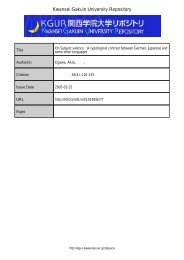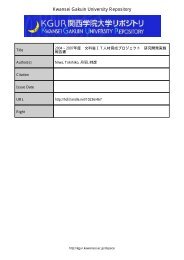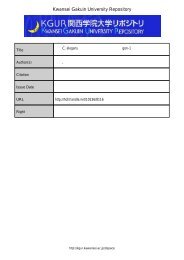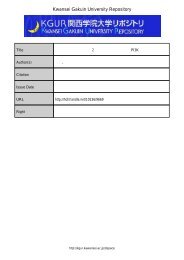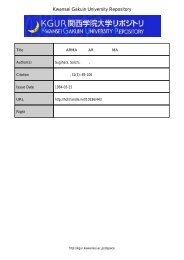Kwansei Gakuin University Repository
Kwansei Gakuin University Repository
Kwansei Gakuin University Repository
Create successful ePaper yourself
Turn your PDF publications into a flip-book with our unique Google optimized e-Paper software.
Heterogeneous Exits: Evidence from New Firms ∗<br />
Masatoshi Kato †,‡<br />
Yuji Honjo §<br />
Abstract<br />
This paper explores heterogeneous exits—bankruptcy, voluntary liquidation,<br />
and merger—by focusing on new firms. Using a sample of<br />
approximately 16,000 firms founded in Japan during 1997–2004, we examine<br />
the determinants of new-firm exit according to forms of exit. Regarding<br />
industry-specific characteristics, our findings indicate that new<br />
firms in capital-intensive and R&D-intensive industries are less likely to<br />
go bankrupt. In industries characterized by large amounts of capital and<br />
low price–cost margins, new firms are more likely to exit through voluntary<br />
liquidation and merger. Region-specific characteristics, such as<br />
regional agglomeration and unemployment rate, have significant effects<br />
on the hazards of exit, and their effects vary across different forms of exit.<br />
Moreover, we provide evidence that firm-specific characteristics, such as<br />
the number of employees, and entrepreneur-specific characteristics, such<br />
as educational background and age, play significantly different roles in<br />
determining each form of exit.<br />
Keywords: New firm; exit; bankruptcy; voluntary liquidation; merger; competing<br />
risks proportional hazards model.<br />
∗ We wish to thank Sadao Nagaoka, Hiroyuki Odagiri, and Hiroyuki Okamuro for their helpful<br />
comments and advice. We also thank the participants at the CEI Seminar and IIR Summer School<br />
of Hitotsubashi <strong>University</strong> in Tokyo, the EARIE Annual Conference in Istanbul, the JEA Autumn<br />
Meeting in Hyogo, and the CAED Conference in London, in 2010, for their comments. In particular,<br />
we are grateful to Masayuki Morikawa for his useful suggestions, which significantly improved the<br />
paper. Financial support from the Japan Society for the Promotion of Science (Grant-in-Aid for<br />
Young Scientists (B) (No. 2173186) for the first author, and Grant-in-Aid for Scientific Research (C)<br />
(No. 20530215) for the second author) is gratefully acknowledged. Needless to say, any remaining<br />
errors are our own.<br />
† School of Economics, <strong>Kwansei</strong> <strong>Gakuin</strong> <strong>University</strong><br />
Address : 1-155 Uegahara Ichiban-cho, Nishinomiya, Hyogo 662-8501, Japan<br />
E-mail : mkato@kwansei.ac.jp<br />
‡ Institute of Economic Research, Hitotsubashi <strong>University</strong><br />
Address : 2-1 Naka, Kunitachi, Tokyo 186-8603, Japan<br />
§ Faculty of Commerce, Chuo <strong>University</strong><br />
Address : 742-1 Higashinakano, Hachioji, Tokyo 192-0393, Japan<br />
E-mail : yhonjo@tamacc.chuo-u.ac.jp



